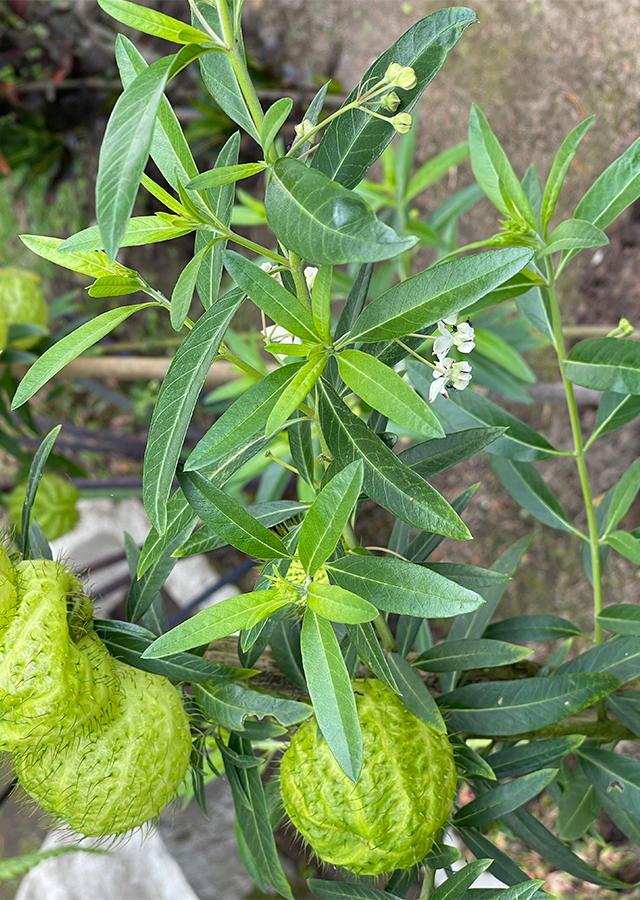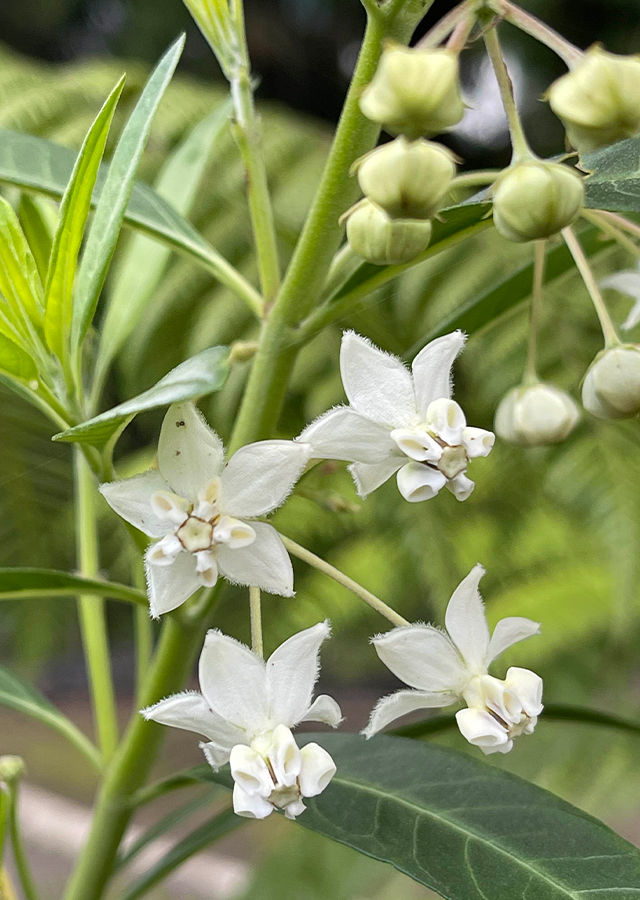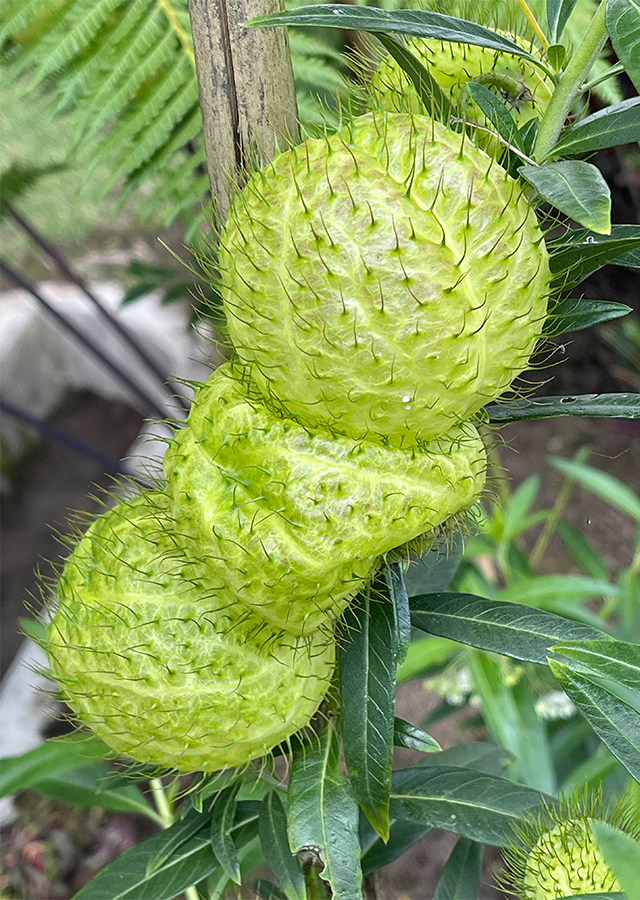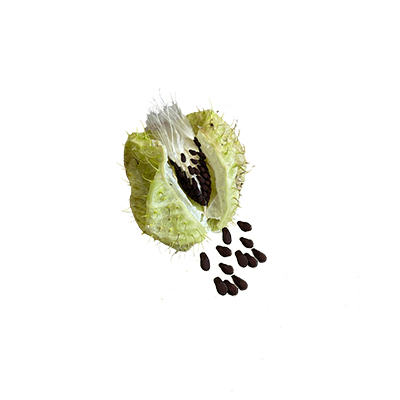Balloon Cotton Bush
Gomphocarpus physocarpus E.Mey.
Apocynaceae
Location in our garden
Principal



Synonym
Asclepias brasiliensis (E.Fourn.) Schltr.
Asclepias physocarpa (E.Mey.) Schltr.
Gomphocarpus brasiliensis E.Fourn.
Habitus
Shrubs. An evergreen shrub growing up to 2 m tall
Part Used
Leaves
Seeds
Latex
Roots
The Whole Plant
Growing Requirements
Full Sunshine
Need Shade
Drought Resistant
Habitat
Wetland
Forest
Coastal
Roadside
Grassland
Terrestrial
Overview
G. physocarpus is native to South Africa, Swaziland and Mozambique. It is cultivated and naturalized in Africa, Mediterranean countries, China, India, Mexico, Central America, and tropical South America. The plant is gathered from the wild for local medicinal use and as a fibre plant. It is also occasionally cultivated as a medicinal plant, especially in China, and, because of its attractive flowers, is often grown as an ornamental in gardens. The plant is said to be used in parts of Africa as an arrow or ordeal-poison. The plant as a whole is poisonous to grazing animals.
Vernacular Names
Dun ding tou guo (Chinese), Algodon falso (Spanish), Algodoeiro-falso (Portuegese), Balmelkbossie (South Africaan), Swanplant (India).
Agroecology
Where native (i.e., South Africa), G. physocarpus grows in grassland and bushland, from the coast to 900 m above sea level. It commonly grows as a weed in waste places, disturbed sites, open woodlands, grasslands, wetlands, and along roadsides and it is also planted as an ornamental in gardens, yards and parks. Succeeds in tropical, subtropical and warm temperate climates. Requires a well-drained soil and a position in full sun.
Morphology
- Roots - tap root.
- Stems - young stems and inflorescences pubescent. Petiole approximately 1 cm; leaf blade narrowly lanceolate, 5-l0 × 0.6-1.5 cm, adaxially sparsely pubescent, abaxially hairy along midvein, both ends tapering or acute. Branches are pale yellowish green and hollow.
- Leaves - light green, opposite, and narrowly oblong to lance-shaped.
- Flowers - flowers in pendulous clusters, corolla white, 1.4-2 cm in diameter; lobes ovate, 8-10 mm, reflexed, margin densely bearded. Corona lobes white, inner margin of hoodlike apex with 2, short, recurved or straight cusps, with a large adaxial nectary. The petals are white and the corona is suffused with pink or purple. The corona surrounds the stamens and carpels composed of ovary, style and stigma. The filaments of the stamens are fused to form a staminal column which encloses the female part. The female part consists of two free carpels, the tips of which are united and enlarged to form the style head. This is the yellowish, 5-lobed disc that can be seen at the centre of the flower. The anthers are fused to the style head. The pollen grains of each anther lobe are united to form two waxy masses known as pollinia or pollen sacs.
- Fruits - large spherical inflated follicles, 6-8 × 2.5-5 cm, base oblique, apex rounded, beakless; pericarp with soft bristles or spines, minutely tomentose when young, glabrescent when ripe.
- Seeds - ovate, approximately 5 mm; coma shining white, approximately 5 mm, each with a tuft of long silky hairs attached at one end.
Cultivation
- Propagated by seeds - surface sow and make sure they do not dry out. Make sure the seedlings are potted on as soon as they are large enough to handle, and plant them out when about 20 cm tall.
- By cuttings of young growth - rooted in a sandy medium.
- By root cuttings.
Chemical Constituents
Phenols, alkaloids, cardiac glycosides (gofruside A and B), steroids/terpenoids.
Traditional Medicinal Uses
- The plant is used medicinally in many parts of Africa, whilst it is also cultivated for medicinal use in China.
- A decoction of all parts of the plant is used as a treatment for stomach troubles.
- A decoction of the plant is taken by mouth for treating asthma and difficulty in breathing. The patient must vomit after taking the dose.
- Applied externally, it is used to treat sores, boils and swellings on the neck. Swellings generally are treated by massaging the area with a decoction of the plant combined with Vernonia appendiculata, whilst for lumbago the plant is dried and mixed with honey to make a paste and then applied with a massage.
- The plant (part unspecified) is taken in small doses for treating excess of bile; it is also used for headaches.
- The leaves are used as a treatment for pulmonary tuberculosis. They are used as a sedative in the treatment of headache and tuberculosis.
- The dried leaves, flowers and young shoots are ground up and used as a snuff given to seriously ill patients. If the patient does not sneeze the case is considered hopeless.
- The roots are used to relieve stomach pain and general aches in the body.
- A latex contained in the plant is used against toothache.
- A decoction of the seeds is used as a cough-medicine.
Part Used
Reference Sources
- Royal Botanic Gardens. Plants of the World Online: Gomphocarpus physocarpus E.Mey.. https://powo.science.kew.org/taxon/urn:lsid:ipni.org:names:97670-1. 16-05-22.
- CAB International. 2022. Invasive Species Compendium: Gomphocarpus physocarpus (balloon cotton bush). https://www.cabi.org/isc/datasheet/114618#tosummaryOfInvasiveness. 16-05-22.
- Fern, Ken. Useful Tropical Medicinal Plants. 2021. Gomphocarpus physocarpus. https://tropical.theferns.info/viewtropical.php?id=Gomphocarpus+fruticosus. 16-05-22.
- Thieme E-Journals - Planta Medica. 2022. Laticifers in the leaves and stems of Gomphocarpus physocarpus: Distribution, structure and chemical composition. https://www.thieme-connect.com/products/ejournals/abstract/10.1055/s-0035-1565636.



